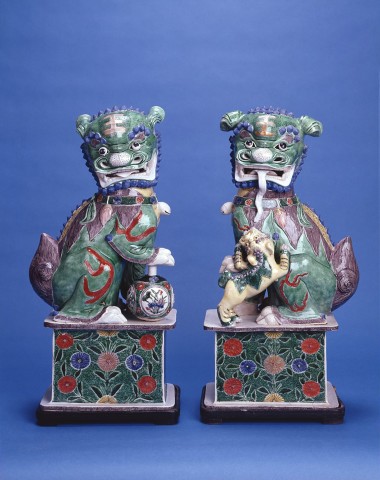Each lion finely moulded affronte, seated on rectangular plinths, the female depicted with her pup holding brocaded ball, the male seated with a brocaded ball with trailing ribbon, decorated in famille verte enamels on the biscuit, the bodies painted pale green, the manes in yellow, aubergine and black enamels, and the curls on top of the head similarly decorated, the plinths with cartouches of fish and aquatic plants on a black background against a background of delicate floral sprays, the sides painted with further lively lion dogs leaping, against a background of flowering blossoms, vigorously modelled in traditional attitude with head turned to one side. Both animals with predominately green bodies with pale manganese mane and tail and other detailing in red and yellow. Each has a blue collar hung with tassels and a bell. Their foreheads with the character wang ['King']. The male with left forepaw resting on a freely turning brocaded ball, his companion with a small yellow cub clambering up her flanks. They are supported on rectangular platformed plinths, the sides embellished with a formal arrangement of different coloured chrysanthemums among leaves and black vermiculé on a green washed ground. The edges of the platforms decorated with squared scroll (leiwen).
Literature
Figures of buddhistic lions are usually found in pairs, the male depicted with a brocaded ball and the female with her cub. Buddhist lions are a classic theme in Chinese art, although the lion is not indigenous to China it was introduced through Indian Buddhism. Pairs of stone lions were probably first employed to guard the entrances to temples and official buildings to frighten away demons towards the end of the Han dynasty or a little after. Also placed as guards of Buddhist temples, this particular placement relates to the lamaistic concept that Buddha upon entering his temple ordered the two lions that accompanied him to seat themselves and wait his return in motionless obedience. The representation of the lion as decoration on Chinese porcelain can be seen from the Ming dynasty onwards, usually depicted in a playful manner, amusing themselves with a brocaded ball and pups.
The brocaded ball, according to legend may represent either a kind of egg enclosing the cub or a pearl. Williams in 1941 relates; "there is an ancient legend that the lion produces milk from its paws, and therefore hollow balls were placed on the hills by the country people, with result that the lions, who enjoyed sporting with the balls would leave some of their milk in them, which the people would secure" (CAS Williams, Outlines of Chinese symbolism and art motives, New York, Dover Publications, 1941, p. 254). There is a connotation of bravery associated with the lions, for under Ming and Qing rule the lion represented the badge of the first military rank. The lions may also symbolise high officials of state. Buddhist lions are often called dogs of Fo, a name given by Europeans, or dogs of Buddha and were very popular in the Kangxi period.
A similar pair of Buddhist lions is illustrated by Walter Bondy, op. cit., p. 181.
出版品
Gordon Lang, 'Polychrome Decoration' in: A Catalogue of Oriental Ceramics and Works of Art, ed. Anita Gray, London, n.d., pp. 43-44, no. 56.

